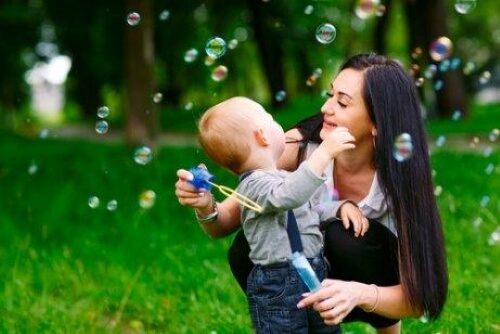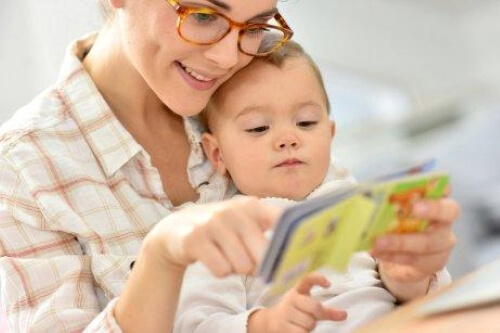7 Activities for a Six-Month-Old Baby

There are many activities for a six-month-old baby that can help to develop his or her new abilities. It’s an age where babies make many big developmental advances in their capabilities and changes in their behavior.
For this reason, it’s very important that you stimulate babies at this age and give them new spaces to explore. This will help them to continue reaching new milestones.
“At six months of age, your baby is more active. Because they are more mobile, it is a good time to assure the house is safe. Put all your cleaning products, medicines, poisons, and sharp objects where the baby cannot reach. Assure that every person who takes care of the baby knows how to keep them safe.”
–The Department of Human and Health Services, USA–
All the activities discussed in the article below will have a positive impact on the physical, cognitive, and emotional development of your baby.
You should also take advantage of the opportunity to strengthen your family bond and spend time together as parent and child while the little one has fun and learns new things.
Take note of the activities below and start putting them into practice with your baby today.
The most productive activities for a six-month-old baby
1. Splash water in a pool
At this age, babies can now sit upright without help when they’re bathing. Put some toys around them and show them how they can make a splash on the water with their own little hand.
In addition to being an activity that’s extremely fun for the baby, sitting upright in a pool also helps to strengthen the muscles in the lower back and improves his or her posture.
2. Songs and nursery rhymes for a six-month-old baby
Sit down or lie down in front of the baby and start to sing a song or a catchy and happy tune. Accompany your voice with movements, gestures, and funny sounds that make the baby smile.
Dance with your baby and encourage him to move along with the rhythm. This will help to develop muscle tone and his gross motor skills.

3. Games with bubbles
Blow soap bubbles near your baby and let him touch his face so he can see all their colors. Try to grab the bubbles and invite him to touch them and to take them in his hands.
With simple activities like this for a six-month-old baby, you’ll help your little one develop visual abilities like following an object. It will also improve hand-eye coordination.
4. Playing with building blocks
Take some colorful building blocks that are an appropriate size for the baby’s hands. Sitting the baby in front of you, guide him and help him to mimic building a tower with the pieces.
Although he won’t achieve this completely, you’ll be helping improve his grasp of objects. Furthermore, like with the previous activity, you’ll strengthen his hand-eye coordination.
Other activities for a six-month-old baby
5. Reading a story
Pick books with the biggest illustrations and brightest colors. Sit the baby on your lap and read to him with a playful voice while he can see every one of your movements and the illustrations.
At first, the words may not captivate him, but the illustrations will get all his attention. Likewise, don’t be surprised if you find your baby babbling and listening to you with a surprised look.
6. Playing with a beach ball
If you have the opportunity to take your baby to a place where you can be in the open air, take advantage of that immediately. First, sit a short distance in front of him with your legs open.
Wait until he’s paying attention to you and roll the ball gently towards him. He’ll try to catch it, move it, and hit it. There is no doubt that this will help muscular development.
7. Activities for a six-month-old baby: Pulling a string
First, make sure you pick a string that is made from soft materials and that won’t rub against the baby’s skin. Second, put one end of the string in your baby’s hand and take the other end in yours.
Finally, pull gently on the cord and wait for the baby to do the same. This activity will help the baby to have a better grasp of objects and it can improve the movement of his fingers.

Other activities for a six-month-old baby, like moving his feet as if he were riding a bicycle can also help him to gain muscle strength.
In conclusion, all these activities will contribute to the healthy development of your baby and it will allow the moments that you spend with him to be opportunities for growth.
In addition, fomenting your baby’s abilities is possible through simple and practical activities that don’t require a lot of time.
There are many activities for a six-month-old baby that can help to develop his or her new abilities. It’s an age where babies make many big developmental advances in their capabilities and changes in their behavior.
For this reason, it’s very important that you stimulate babies at this age and give them new spaces to explore. This will help them to continue reaching new milestones.
“At six months of age, your baby is more active. Because they are more mobile, it is a good time to assure the house is safe. Put all your cleaning products, medicines, poisons, and sharp objects where the baby cannot reach. Assure that every person who takes care of the baby knows how to keep them safe.”
–The Department of Human and Health Services, USA–
All the activities discussed in the article below will have a positive impact on the physical, cognitive, and emotional development of your baby.
You should also take advantage of the opportunity to strengthen your family bond and spend time together as parent and child while the little one has fun and learns new things.
Take note of the activities below and start putting them into practice with your baby today.
The most productive activities for a six-month-old baby
1. Splash water in a pool
At this age, babies can now sit upright without help when they’re bathing. Put some toys around them and show them how they can make a splash on the water with their own little hand.
In addition to being an activity that’s extremely fun for the baby, sitting upright in a pool also helps to strengthen the muscles in the lower back and improves his or her posture.
2. Songs and nursery rhymes for a six-month-old baby
Sit down or lie down in front of the baby and start to sing a song or a catchy and happy tune. Accompany your voice with movements, gestures, and funny sounds that make the baby smile.
Dance with your baby and encourage him to move along with the rhythm. This will help to develop muscle tone and his gross motor skills.

3. Games with bubbles
Blow soap bubbles near your baby and let him touch his face so he can see all their colors. Try to grab the bubbles and invite him to touch them and to take them in his hands.
With simple activities like this for a six-month-old baby, you’ll help your little one develop visual abilities like following an object. It will also improve hand-eye coordination.
4. Playing with building blocks
Take some colorful building blocks that are an appropriate size for the baby’s hands. Sitting the baby in front of you, guide him and help him to mimic building a tower with the pieces.
Although he won’t achieve this completely, you’ll be helping improve his grasp of objects. Furthermore, like with the previous activity, you’ll strengthen his hand-eye coordination.
Other activities for a six-month-old baby
5. Reading a story
Pick books with the biggest illustrations and brightest colors. Sit the baby on your lap and read to him with a playful voice while he can see every one of your movements and the illustrations.
At first, the words may not captivate him, but the illustrations will get all his attention. Likewise, don’t be surprised if you find your baby babbling and listening to you with a surprised look.
6. Playing with a beach ball
If you have the opportunity to take your baby to a place where you can be in the open air, take advantage of that immediately. First, sit a short distance in front of him with your legs open.
Wait until he’s paying attention to you and roll the ball gently towards him. He’ll try to catch it, move it, and hit it. There is no doubt that this will help muscular development.
7. Activities for a six-month-old baby: Pulling a string
First, make sure you pick a string that is made from soft materials and that won’t rub against the baby’s skin. Second, put one end of the string in your baby’s hand and take the other end in yours.
Finally, pull gently on the cord and wait for the baby to do the same. This activity will help the baby to have a better grasp of objects and it can improve the movement of his fingers.

Other activities for a six-month-old baby, like moving his feet as if he were riding a bicycle can also help him to gain muscle strength.
In conclusion, all these activities will contribute to the healthy development of your baby and it will allow the moments that you spend with him to be opportunities for growth.
In addition, fomenting your baby’s abilities is possible through simple and practical activities that don’t require a lot of time.
All cited sources were thoroughly reviewed by our team to ensure their quality, reliability, currency, and validity. The bibliography of this article was considered reliable and of academic or scientific accuracy.
- Blasco, J. (1992). El estadio del espejo. Introducción a la teoría del yo en Lacan. Barcelona: Espacio Psicoanalítico de Barcelona. Universidad Nacional Autónoma de México. https://www.rua.unam.mx/portal/recursos/ficha/74495/el-estadio-del-espejo-introduccion-a-la-teoria-del-yo-en-lacan
- Cadena, B., León, A., Pasquel, E., & Usamá, Y. (2020). Propuesta de estimulación temprana para el desarrollo infantil. Boletín Informativo CEI, 7(1), 83-89. https://revistas.umariana.edu.co/index.php/BoletinInformativoCEI/article/view/2204
- Celayeta Lazcano, A., & Cuesta Abil, A. (2015). La fisioterapia como método de apoyo y de prevención durante el desarrollo del bebé sano de 0 a 2 años. Escuela Universitaria Gimbernat. https://eugdspace.eug.es/handle/20.500.13002/527
- Cepeda, A. (2009). Afecto y aprendizaje en la sala cuna. Experiencias didácticas para niños de 6 meses a 3 años. https://bibliotecadigital.mineduc.cl/bitstream/handle/20.500.12365/16961/Cuaderno-6.pdf?sequence=1&isAllowed=y
- Enesco, I. (2012). Desarrollo del conocimiento de la realidad en el bebé. JA Castorina & M. Carretero (Comps.), Desarrollo cognitivo y educación. Los inicios del conocimiento, 1, 165-193.
- García, Z., & Dennise, M. (2021). Juguete para la estimulación de gateo en niños de 6 a 12 meses. Pontificia Universidad Católica del Ecuador.
- González Vargas, A. H. (2014). La adquisición del lenguaje y la gestualidad en la interacción adulto-bebé-objeto. Fuentes Humanísticas, Año 28, Número 49, II Semestre 2014, pp. 97-111. http://zaloamati.azc.uam.mx/handle/11191/5116
- Guerra, G., & Julio, C. (2012). El agua, espacio de aprendizajes : propuesta metodológica para la estimulación adecuada en niños de 6 meses a 2 años de edad en medio acuático. Universidad del Valle. https://bibliotecadigital.univalle.edu.co/handle/10893/3871
- Gusqui-Chano, K. E., Ríos-López, T. D., Caizaluisa-Barros, N. F., & Pazmiño-Arcos, A. F. (2022). La estimulación temprana como medio principal para desarrollar el área socio-afectiva en los dos primeros años de vida. Maestro y Sociedad, 19(2), 732-745. https://maestroysociedad.uo.edu.cu/index.php/MyS/article/view/5551
- Martí, J. M. (2017). Cómo potenciar la inteligencia de los niños con la música: Desarrolle sus habilidades motrices, lingüísticas, matemáticas y psicosociales. Ma Non Troppo. https://books.google.es/books?id=DPB4DwAAQBAJ&dq=Canciones+y+rimas+infantiles+para+el+beb%C3%A9+de+seis+meses+tono+muscular+habilidades+motoras&lr=&hl=es&source=gbs_navlinks_s
- Mendez, L., & Susana, J. (2015). Juegos de construcción para reforzar la coordinación viso-motriz de los niños y niñas de nivel inicial 1 de la escuela de educación básica los Ositos Graciosos del Cantón La Libertad, provincia de Santa Elena, año lectivo 2015 – 2016. La Libertad: Universidad Estatal Península de Santa Elena, 2015.
- Morales Suárez, A., & Rincón Lozada, C. F. (2016). Relación entre madurez neuropsicológica y presencia–ausencia de la conducta de gateo. Acta de investigacion psicologica, 6(2), 2450–2458. https://doi.org/10.1016/j.aipprr.2016.06.008
- Moreno, J. A., & De Paula, L. (2005). Actividades Acuáticas para el primer año de vida del bebé. In En Actas de II Congreso Internacional de Actividades Acuáticas (pp. 171-188).
- Ortega-López, L. (2014). Adquisición del lenguaje infantil: Las primeras palabras. Universidad de Jaén, Departamento de Filología Española. https://tauja.ujaen.es/handle/10953.1/1064
- Sumbland, C. (2008). 50 actividades para estimular a tu bebé: 0-12 meses. Imaginador.
- Sánchez, N., & Jazmina, E. (2015). Gimnasio portátil para actividades de estimulación temprana en bebés de 6 a 12 meses del programa Creciendo con Nuestros Hijos del Mies. Pontificia Universidad Católica del Ecuador Sede Ambato. https://repositorio.pucesa.edu.ec/handle/123456789/1250
- Sancho, V. A., de Gauna, C. E. I., Florez, C. C., & Saborit, B. V. (2005). Material sensorial (0-3 años): Manipulación y experimentación. Editorial. https://books.google.es/books?id=8lFq8mS59XwC&dq=pompas+de+jab%C3%B3n+seguimiento+de+objetos+6+meses&lr=&hl=es&source=gbs_navlinks_s
- Serrano, P., & de Luque, C. (2019). Motricidad fina en niños y niñas: Desarrollo, problemas, estrategias de mejora y evaluación. Narcea Ediciones. https://books.google.es/books?id=NPikDwAAQBAJ&dq=tirar+cuerda+jugar+pelota+6+meses&lr=&hl=es&source=gbs_navlinks_s
- United States Department of Education Ed. (2002). Buen comienzo, Buen futuro: El Bebe de seis meses (healthy start, grow smart: Your six-month old). Bibliogov. https://www2.ed.gov/espanol/healthystart/sixmonthspanish.pdf
- United States Department of Education Ed. (2011). Buen comienzo, Buen futuro: El Bebe de seis meses (healthy start, grow smart: Your six-month old). Bibliogov. https://www2.ed.gov/espanol/healthystart/sixmonthspanish.pdf
- Vargas, G., & Hilary, A. (2014). La adquisición del lenguaje y la gestualidad en la interacción adulto-bebé-objeto. Fuentes humanísticas. http://zaloamati.azc.uam.mx/handle/11191/5116
This text is provided for informational purposes only and does not replace consultation with a professional. If in doubt, consult your specialist.








